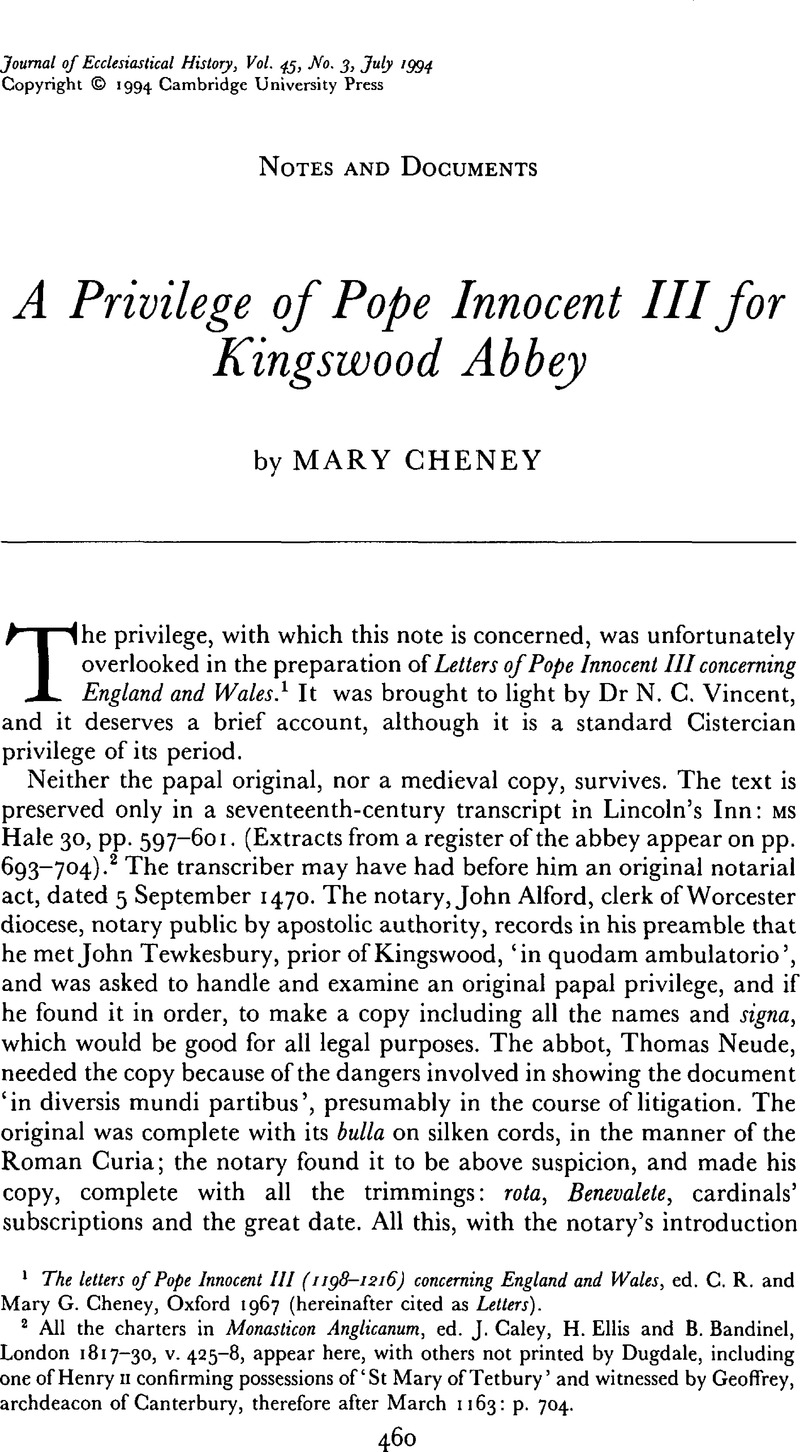No CrossRef data available.
Published online by Cambridge University Press: 06 February 2009

1 The letters of Pope Innocent III (11981216) concerning England and Wales, ed. C. R., and Cheney, Mary G., Oxford 1967 (hereinafter cited as Letters).Google Scholar
2 All the charters in Monasticon Anglicanum, ed. Caley, J., Ellis, H. and Bandinel, B., London 1817–1830, V. 425–8Google Scholar, appear here, with others not printed by Dugdale, including one of Henry 11 confirming possessions of ‘St Mary of Tetbury’ and witnessed by Geoffrey, , archdeacon of Canterbury, , therefore after 03 1163: p. 704Google Scholar.
3 Die päpstlichen Kanzleiordnungen von 1200–1500, ed. Michael Tangl, Innsbruck 1894, repr. Aalen 1959, 229–32.
4 Letters, no. 518.
5 Maleczek, Werner, Papst und Kardinalskolleg von 1191 bis 1216, Vienna 1984, 126–8Google Scholar.
6 Cowlcy, F. G., The monastic order in South Wales (1066–1349), Cardiff 1977Google Scholar.
7 On the interdict see Cheney, C. R., Pope Innocent 111 and England, Stuttgart 1976, 301–25Google Scholar, and, with reference to Cistercian privileges, Berthold-Mahn, Jean, L'ordre cistercien et son gouvernement 1098–1216, Paris 1945, 93–7Google Scholar. The interdict on England was a special case, since it was laid by order of the pope himself, and expressly over-rode privileges and exemptions, whereas the exemption granted to the order was always envisaged as an aspect of Cistercian freedom from the control of the diocesan. On this theme see Pfurtscheller, P., Die Privilegierung des Zisterzienserordens…bis zur Bulle Parvus fons (1265), Frankfurt 1972Google Scholar.
8 For example, Letters, nos 101 (Premonstratensian), 268 (Cluniac), 297 (Benedictine), 1125 (Premonstratensian).
9 Statuta capilulorum generalium ordinis Cisterciensis 1116–1786, ed. Canivez, J. M., i, Louvain 1935, 89, 259Google Scholar.
10 The source for the following account is a letter written by E(udo), abbot of Tintern, in 1192, printed in Mon. Ang. v. 425–6, from a lost cartulary of Kingswood. The Hale MS has the same text, with a few better readings. The sequence of events was worked out by Morey, Adrian and Brooke, C. N. L. in Letters and charters of Gilbert Foliot, Cambridge 1967, 510–13Google Scholar.
I have followed this account, but have laid greater emphasis on the threatened establishment of a second abbey at Kingswood. I have ignored additional complications such as the relations between Kingswood and Tintern, and the dispossession of the Berkeley family by Henry II.
11 See above n. 2.
12 Wood, Susan, English monasteries and their patrons in the XIII century, Oxford 1955, 27–8Google Scholar.
13 Statuta capitulorum, 153, 170–1.
14 Hereinafter c.p.s.
15 I am grateful to the staff of the Gloucestershire Record Office, who suggested identification with Calcot Farm, as noted by Smith, A. H., Place-names of Gloucestershire, ii (English Place-name Society xxxix, 1964), 239Google Scholar. All places named are in Gloucestershire.
16 The name seems to have been corrected from Rocroad or Rocrood; it has not been identified.